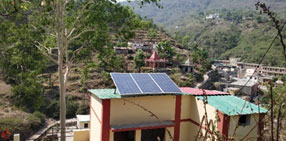IIEC Recent News
Improved Access to Electricity – Need of the Day for Poor to be Connected at this Time when the World is under Lockdown
Sumedha Awasthy, Program Manager, International Institute for Energy Conservation (www.iiec.org)
Richa Shrivastav, Program Manager, Shree Shakti Consciousness Foundation (www.sscf.in)
As the COVID-19 being spread across the world, the most required prevention measure is not the luxury, but the ways to meet the basic needs of the poor to protect them from the pandemic before it penetrates down at the community level. The kind of prevention measures like lockdown, curfew and stay at home being adopted in India, can only bring successful results when the communities in rural areas have access to reliable, affordable electricity to stay connected and continue to communicate with public services and with one another remotely.
 A good number of communities living in rural areas and the infrastructure provided to serve their needs about health, education and livelihood generation are still surviving without access to affordable and reliable electricity and millions more have access to very limited or unreliable supply of electricity. Living under lockdown for long periods may not be possible in remotely located villages without the availability of energy to cook and store food, or for entertainment (use of TV or radio) and communication using mobile phones.
A good number of communities living in rural areas and the infrastructure provided to serve their needs about health, education and livelihood generation are still surviving without access to affordable and reliable electricity and millions more have access to very limited or unreliable supply of electricity. Living under lockdown for long periods may not be possible in remotely located villages without the availability of energy to cook and store food, or for entertainment (use of TV or radio) and communication using mobile phones.
The ability of health workers to treat infected people is also based on the assumption that remotely located Primary Health Clinics (PHCs) and their equipment and freezers can only function with available access to uninterrupted supply of electricity.
As the spread of the pandemic is growing, the situation is becoming challenging for health workers and PHCs as they are the first line medical service providers for the poor living in remote villages as they try to treat patients with facilities that rely on electricity. And even when treatments become available, the restricted cold chains (due to lockdown) and the refrigeration facilities make the poor more vulnerable due to interrupted supplies of vaccines for dog bites, snake bites or tetanus injections to provide protection against possible infections from wounds and bruises.
The off grid decentralized renewable power can answer this challenge for effectively delivering health, education and livelihood generation services. The off-grid energy solutions not only allow the people to access the needed healthcare but also ensure investment in clean and sustainable energy infrastructure for the future.
The not for profits and international funding agencies can join the hands with the Local Governments in India to jointly respond to this problem.
Ensure Access to Clean Energy for Primary Health Clinics
 The primary health care services will need to deal with emergencies during the pandemic and eventually help in administering safe therapeutics by providing the most required information on prevention and safety to check the spread of the virus. These PHCs should be provided with the infrastructure to ensure the availability of clean and sustainable electricity using solar or other renewable sources. Solar powered PHCs in remote villages with the basic facility of refrigeration, X-Ray viewers, Nebulizers, ECG measurement, 24x7 LED lighting and outside lighting can change the way about how health services normally function in remote areas. In the absence of electricity supplies, most patients get referred to hospitals in nearby towns inviting higher treatment costs due to expenses on travel and other logistics. Poor cannot afford it all the time.
The primary health care services will need to deal with emergencies during the pandemic and eventually help in administering safe therapeutics by providing the most required information on prevention and safety to check the spread of the virus. These PHCs should be provided with the infrastructure to ensure the availability of clean and sustainable electricity using solar or other renewable sources. Solar powered PHCs in remote villages with the basic facility of refrigeration, X-Ray viewers, Nebulizers, ECG measurement, 24x7 LED lighting and outside lighting can change the way about how health services normally function in remote areas. In the absence of electricity supplies, most patients get referred to hospitals in nearby towns inviting higher treatment costs due to expenses on travel and other logistics. Poor cannot afford it all the time.
Ensure that the Vulnerable Communities are Connected
 The next is to look for affordable solutions for the households using the off-grid solutions like mini grids or solar home systems if it is not at all possible to provide grid connections. These poor households are unable to afford paying for the electricity and they always face the risk of being disconnected. To overcome, the State Governments and the elected members of legislative assemblies should work with private developers, service providers, and vendors to ensure the delivery of uninterrupted electricity and the poor should not be deprived of access to energy due to their financial conditions. The time is critical as the livelihood generation resources are shrinking due to the lockdown situation. The donor agencies and NGOs along with investors should come forward to support this cause to keep the communities connected. Various business models can also be evolved to keep the interest alive for all stakeholders.
The next is to look for affordable solutions for the households using the off-grid solutions like mini grids or solar home systems if it is not at all possible to provide grid connections. These poor households are unable to afford paying for the electricity and they always face the risk of being disconnected. To overcome, the State Governments and the elected members of legislative assemblies should work with private developers, service providers, and vendors to ensure the delivery of uninterrupted electricity and the poor should not be deprived of access to energy due to their financial conditions. The time is critical as the livelihood generation resources are shrinking due to the lockdown situation. The donor agencies and NGOs along with investors should come forward to support this cause to keep the communities connected. Various business models can also be evolved to keep the interest alive for all stakeholders.
 Energy access can save lives and it can protect vulnerable populations. This is high time to act, the solutions are available, we just need to facilitate the process. This is high time to implement.
Energy access can save lives and it can protect vulnerable populations. This is high time to act, the solutions are available, we just need to facilitate the process. This is high time to implement.
Ongoing Efforts by IIEC and SSCF
In the State of Uttarakhand in India, the International Institute for Energy Conservation (IIEC) (www.iiec.org) and Shree Shakti Consciousness Foundation (SSCF) (www.sscf.in) are working with Department of Health and Department of Education to ensure improved access to electricity to deliver health and education services. The program is empowering the health and education sectors to perform efficiently with improved availability of electricity using solar energy. This model is easy to implement and support both the communities and the Government in terms of using and delivering better services with improved use of available infrastructure in the villages. The program is working as a facilitator. The difference between IIEC and SSCF implemented the program and the other programs is about the approach – Where we are not trying to act parallel to the Government programs, we are just adding the value to what is existing in the villages. The first phase of the program is funded by Syneos Health and Sharon Limaye Foundation.

Figure 1: Increase in Number of Diseases being Treated after Installation of Solar Energy Systems

Figure 2: Increase in Number of Patients after PHCs have Started Functioning due to Improved Access to Electricity
We pledge to the national and international communities to join hands with us in reaching out to a greater number of villages in difficult terrains of Uttarakhand. So far, we have reached out to 15 villages to make the change. The Figure-1 shows the increase in number of diseases treated after the installation of solar energy systems. The Figure-2 shows the increase in the number of patients after PHCs have started functioning due to improved access to electricity. These examples show that the improved access to electricity can empower the health workers to treat people well and keep them healthy so that the immunity against new threats like COVID-19 can be handled well in remote areas.
About the Authors:
 Sumedha Awasthy is working as Program Manager at International Institute for Energy Conservation (IIEC). She is a clean energy, climate change and natural resources management expert. She completed her M.Sc. in Resource Management and Design Applications from University of Delhi, India in 2017 and since then she is working on key national and international programs like increased integration of renewable energy in buildings, revision of state climate change action plans, GHG accounting of various cities, implementation of clean energy access program and building the capacity of Farmer Producer Companies (FPCs) for better management of business and finances. She leads IIECs flagship program on Clean Energy Access.
Sumedha Awasthy is working as Program Manager at International Institute for Energy Conservation (IIEC). She is a clean energy, climate change and natural resources management expert. She completed her M.Sc. in Resource Management and Design Applications from University of Delhi, India in 2017 and since then she is working on key national and international programs like increased integration of renewable energy in buildings, revision of state climate change action plans, GHG accounting of various cities, implementation of clean energy access program and building the capacity of Farmer Producer Companies (FPCs) for better management of business and finances. She leads IIECs flagship program on Clean Energy Access.
 Richa Shrivastav is currently Program Manager for IT and Community Empowerment at Shree Shakti Consciousness Foundation (SSCF). In the past, she worked as a System Engineer at Infosys Limited. She is a Computer Science Engineer and holds a Bachelor of Technology from United College of Engineering and Research Allahabad, India. She also attended the Asian Institute of Technology (AIT), Thailand workshop on Latest Technological Development.
Richa Shrivastav is currently Program Manager for IT and Community Empowerment at Shree Shakti Consciousness Foundation (SSCF). In the past, she worked as a System Engineer at Infosys Limited. She is a Computer Science Engineer and holds a Bachelor of Technology from United College of Engineering and Research Allahabad, India. She also attended the Asian Institute of Technology (AIT), Thailand workshop on Latest Technological Development.

